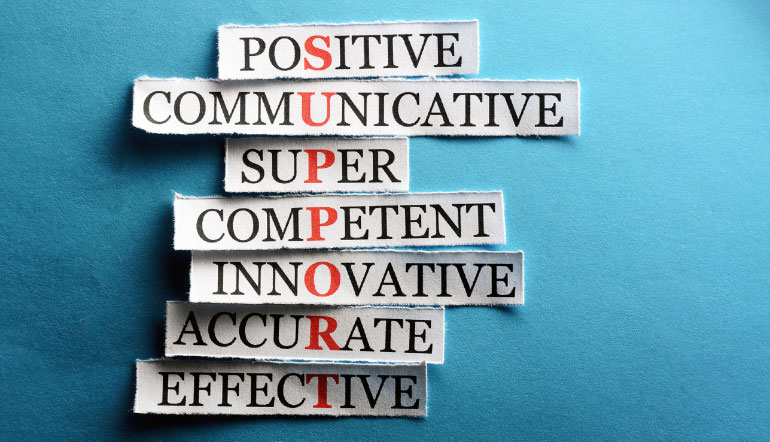
We all know the old adage, “you never get a second chance to make a first impression.” But did you ever stop to think that this concept also applies to your live chat service?
It can be difficult to form the right greeting messages to gain a client’s trust. But a customer’s judgment dictates your ability to serve him or her. So let’s take a closer look at the importance of effective greetings and how you can harness the power of a good first impression — virtually.
This is how a live chat expert Kevin Gao explains the significance of the very first words you use when chatting to customers via live chat and he’s 100% right.
Let’s further check out his wonderful blog post The Power of Hello: 4 Steps to Create Effective Live Chat Greetings and see what else he says about why first impressions matter so much in.
Note: Don’t forget to carefully read the whole article later in this lesson and learn the simple steps you can keep in mind when greeting a customer to make a good impression.
It takes 1/10th of a second to make a judgment based off of someone’s face, according to the researchers at Princeton University.
Can you imagine how fast that is?
It takes three times as long to blink an eye. A fast website loads in a few seconds. As quickly as a hummingbird beats his wing, we form opinions about how trustworthy others are.
Further research at the University of Glasgow shows that something as simple as how you say the word “hello” dictates how people perceive you.
As a customer service agent, you might suddenly feel relieved that you serve customers through live chat and that no one can read your face or hear your voice.
But you shouldn’t get too comfortable just because you feel that you’re hiding behind a screen.
In the live chat industry, word choice still matters — using the wrong words, according to psychologists, can release stress-inducing hormones in our brains. If you use the wrong words, they can act like weapons against you instead of tools.
Now that you’ve realized how significant those first few lines in chatting with your online customers are, we can dive deeper.
Thus, in this lesson, we’re going to deal with the basics of live chat greetings and chitchat:
- Overcoming a common fear of speaking to foreigners
- Setting the right tone for the conversation with a friendly greeting, and
- Etiquette and getting personal with your customers
Now, let’s get rid of that fear first, shall we? Or at least allay it for start.
Overcoming the Fear of Speaking to Foreigners
You’re here because you want to build a steady online career and become a skilled Customer Service Representative, right?
So far so good. You’re dedicated to lifelong learning and you’re enjoying your courses. You love talking to people and helping them.
However, things might sometimes change when it comes to making a professional conversation in a non-native language.
Find it difficult to work out how to get such a conversation going?
Feel a growing discomfort when you have to speak to people in a foreign language?
Ashamed of it a bit? Wondering if it’s normal?
No worries! Everything’s OK with you!
No, you’re NOT crazy!
No, you’re NOT the only one who has the fear of speaking to foreigners! Many people do.
The fear probably doubles when you know your income depends on the way you speak to foreigners in a foreign language.
It’s not easy to properly greet a customer and set the right tone of the conversation even in your native language, right?
The most likely cause of such a fear can be found in the lack of English skills. Fortunately, this problem can be easily solved!
If you don’t feel confident enough and need to improve your English skills, we’ve got a fantastic tailor-made course for you to help you boost your confidence and hone your speaking and writing skills.
Our Basic English Language Training will equip you with all the helpful tools, resources, tips and tricks for perfecting your English effortlessly.
What’s more, we’ll help you change your attitude towards learning the language by busting the most common myths.
Make sure you’ve done this course because it will provide you with the necessary knowledge and the efficient strategy to improve your conversational and writing skills.
This will consequently help you a lot to overcome the fear. Then, you’ll be able to focus on the central topic of this lesson – greetings and chitchat.
Ready? Let’s move on.
Getting a Live Chat Conversation Started
When initiating contact with CSRs via live chat, customers normally just dive into a question, so you can start answering it straightaway.
But think about it for a moment. Is it really the right way to engage in a conversation with the customer?
Still, a little bit of chitchat like a friendly greeting is exceptionally important because it sets the tone for the conversation, which can further influence your long-term relationship with the customer. Don’t you agree?
Another credible source agrees with our viewpoint above. Here’s what they say…
However you get it started, a greeting is foundational to any human interaction. Greetings help us connect on a personal level and set the tone for a positive conversation. Warm and friendly greetings can help forge new connections between strangers and welcome back old friends.
Although mediated through a computer, live chat is at its basis a conversation between two people. And as with any conversation, live chats should always incorporate a welcoming greeting to get things off on the right foot.
So, just what makes for a welcoming live chat greeting?
Refer to the 16 outstanding example messages of live chat greetings. Not all of them will be appropriate for every customer, but you may tweak them a bit to fit your company’s style and philosophy, as well as particular situations you find yourself in.
According to the article 4 ways to create effective chat greetings for building good customer relationships, it’s critical to:
- Add human touch to your conversation
- Avoid using canned messages too frequently
- Introduce yourself first
- Avoid typo errors, grammatical and spelling errors
- Make your greeting short and precise
So, always bear this in mind.
Also, remember that customers don’t use live chat ONLY if they have questions. It allows you also to engage with them proactively for offering instant assistance.
It matters a lot what you will write to the customer for initiating a live chat session. So, make sure you thoroughly read the whole article about creating effective chat greeting linked above and take a closer look on how you can create the perfect live chat greeting for your customers and make a good first impression.
Here’s a good example of one such conversation starter from the linked article:
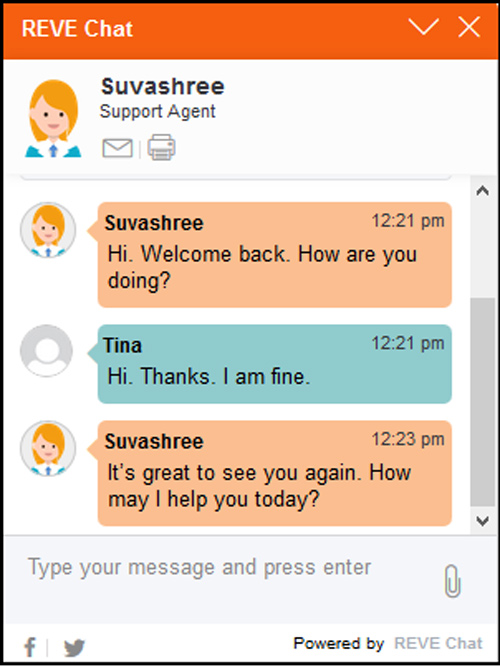
And here’s another similar example from the same source:
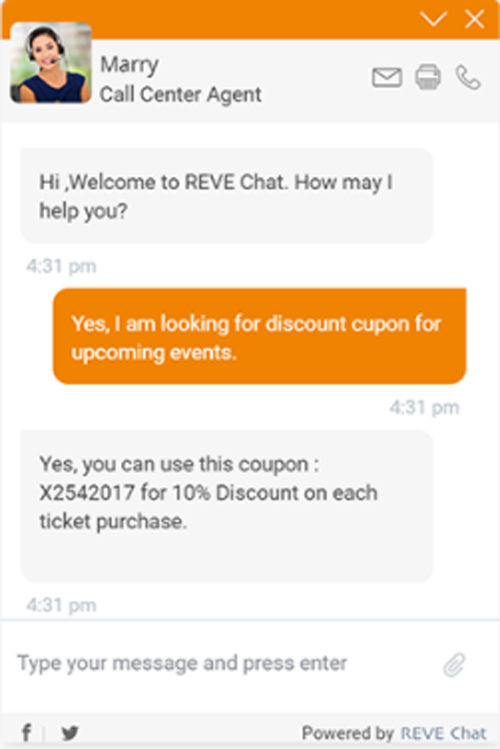
B2C Live Chat | 5 Common Mistakes by Support Agents offers one more example of a warm and friendly greeting.
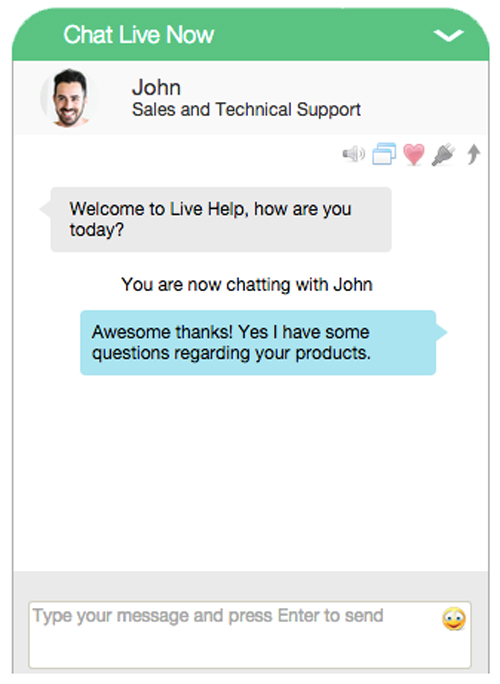
How to Use Customized Messages to Engage with Your Website Visitors also talks about using live chat proactively and offers some wonderful examples of messages you could use to start a friendly, personalized conversation with your customers in different situations.
So, follow the link and read more about it. What are you waiting for?
Why should I set up chat greetings gives you more insights into the power of live chat greetings, their benefits, reasons for creating them and the steps on how to create your first custom greeting. Go through this article to learn what you need to know about that topic.
Also, check out the LiveChat infographic showing the effectiveness of various greetings on various pages at various times.
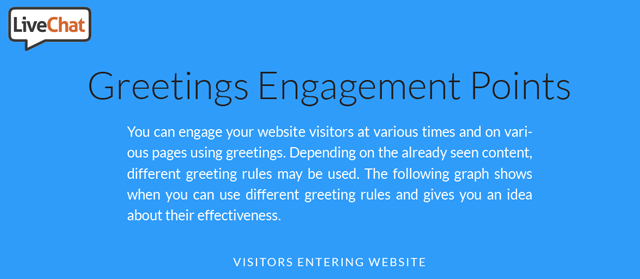
Let’s check out some examples of friendly greetings from the LiveChat tool’s customization options.
Example 1:
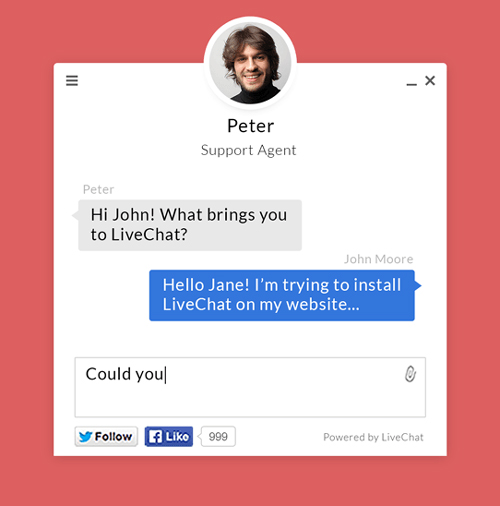
Example 2:
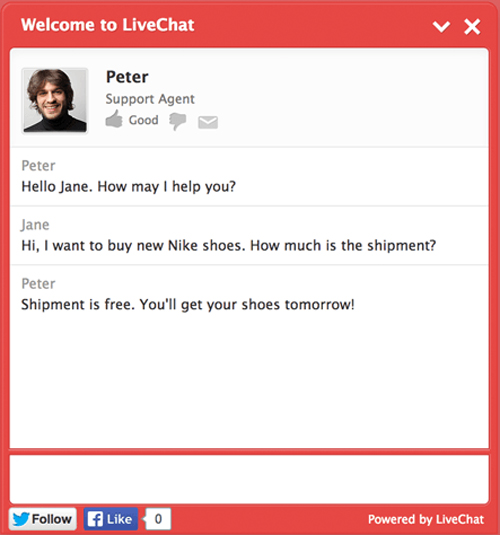
Example 3:
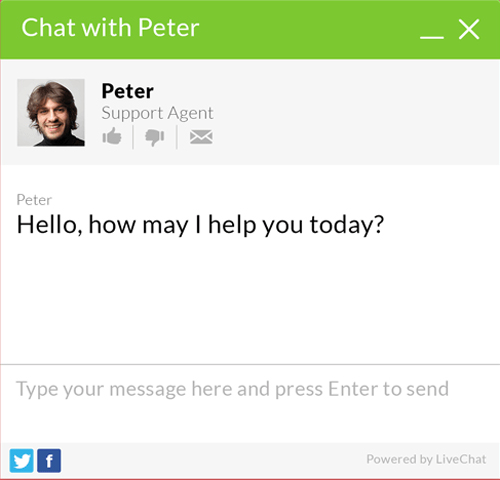
And here’s another example of initiating a friendly conversation and letting your customer know you’ll be there for them taken from Top 20 Live Chat Software Solutions of 2018.
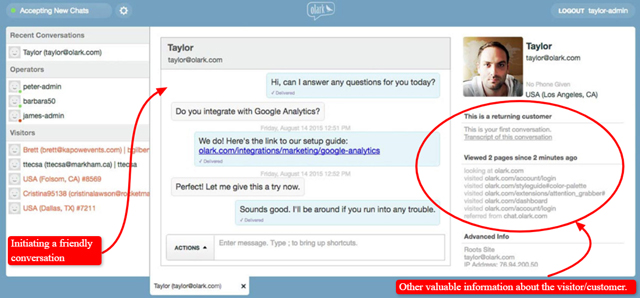
As advised in the article Make Your First Impression The Best Impression With Live Chat, make sure that none of your greetings is too long or too short. In fact, it should be a concoction of professionalism, personalization, and friendliness.
Customers expect personalization. They look forward to interacting with a human and get their queries resolved, so convince them that they’re interacting with a real human and not a chatbot.
Modify the canned greetings to radiate positive energy through live chat. Once you have these greetings ready, you are all set to create that ‘best’ impression!
Check out the valuable tips from 16 Live Chat Best Practices to Help You Deliver Superior Customer Service to help you create a more human connection over live chat.
What’s more, pay attention to the comparison of their good vs bad example of being human in a live chat conversation.
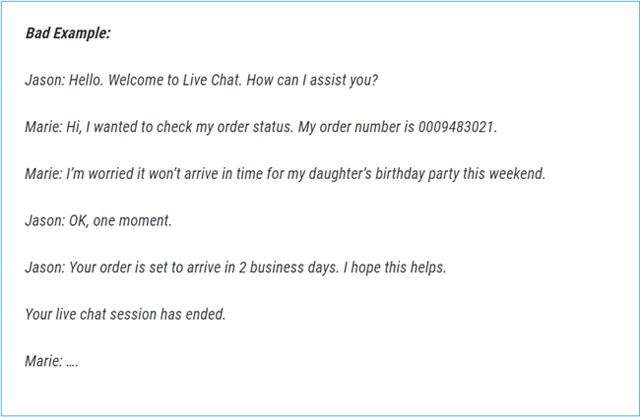
As you can see from the above interaction, Jason provided the customer with a subpar interaction. He failed to address the customer by her name, and never gave her his name either, making the exchange feel impersonal and robotic.
He also failed to acknowledge and empathize with the customer’s concern. Jason’s tone was very stiff and as a result failed to represent the brand positively. He also ended the chat abruptly, potentially leaving Marie with unanswered questions.
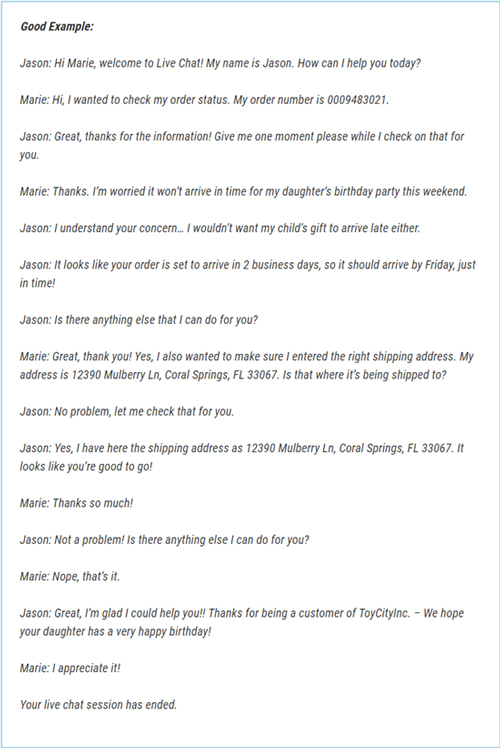
Getting a live chat conversation started
When initiating contact with CSRs via live chat, customers normally just dive into a question, so you can start answering it straightaway.
But think about it for a moment. Is it really the right way to engage in a conversation with the customer?
Still, a little bit of chitchat like a friendly greeting is exceptionally important because it sets the tone for the conversation, which can further influence your long-term relationship with the customer. Don’t you agree?
Another credible source agrees with our viewpoint above. Here’s what they say…
However you get it started, a greeting is foundational to any human interaction. Greetings help us connect on a personal level and set the tone for a positive conversation. Warm and friendly greetings can help forge new connections between strangers and welcome back old friends.
Although mediated through a computer, live chat is at its basis a conversation between two people. And as with any conversation, live chats should always incorporate a welcoming greeting to get things off on the right foot.
So, just what makes for a welcoming live chat greeting?
Refer to the 16 outstanding example messages of live chat greetings. Not all of them will be appropriate for every customer, but you may tweak them a bit to fit your company’s style and philosophy, as well as particular situations you find yourself in.
According to the article 4 ways to create effective chat greetings for building good customer relationships, it’s critical to:
- Add human touch to your conversation
- Avoid using canned messages too frequently
- Introduce yourself first
- Avoid typo errors, grammatical and spelling errors
- Make your greeting short and precise
So, always bear this in mind.
Also, remember that customers don’t use live chat ONLY if they have questions. It allows you also to engage with them proactively for offering instant assistance.
It matters a lot what you will write to the customer for initiating a live chat session. So, make sure you thoroughly read the whole article about creating effective chat greetings linked above and take a closer look on how you can create the perfect live chat greeting for your customers and make a good first impression.
Here’s a good example of one such conversation starter from the linked article:
And here’s another similar example from the same source:
B2C Live Chat | 5 Common Mistakes by Support Agents offers one more example of a warm and friendly greeting.
How to Use Customized Messages to Engage with Your Website Visitors also talks about using live chat proactively and offers some wonderful examples of messages you could use to start a friendly, personalised conversation with your customers in different situations.
So, follow the link and read more about it. What are you waiting for?
Why should I set up chat greetings gives you more insights into the power of live chat greetings, their benefits, reasons for creating them and the steps on how to create your first custom greeting. Go through this article to learn what you need to know about that topic.
Also, check out the LiveChat infographic showing the effectiveness of various greetings on various pages at various times.
Click the image to view the whole infographic
Let’s check out some examples of friendly greetings from the LiveChat tool’s customisation options.
Example 1:
Example 2:
Example 3:
And here’s another example of initiating a friendly conversation and letting your customer know you’ll be there for them taken from Top 20 Live Chat Software Solutions of 2018.
As advised in the article Make Your First Impression The Best Impression With Live Chat, make sure that none of your greetings is too long or too short. In fact, it should be a concoction of professionalism, personalisation, and friendliness.
Customers expect personalisation. They look forward to interacting with a human and get their queries resolved, so convince them that they’re interacting with a real human and not a chatbot.
Modify the canned greetings to radiate positive energy through live chat. Once you have these greetings ready, you are all set to create that ‘best’ impression!
Check out the valuable tips from 16 Live Chat Best Practices to Help You Deliver Superior Customer Service to help you create a more human connection over live chat.
What’s more, pay attention to the comparison of their good vs bad example of being human in a live chat conversation.
As you can see from the above interaction, Jason provided the customer with a subpar interaction. He failed to address the customer by her name, and never gave her his name either, making the exchange feel impersonal and robotic.
He also failed to acknowledge and empathise with the customer’s concern. Jason’s tone was very stiff and as a result failed to represent the brand positively. He also ended the chat abruptly, potentially leaving Marie with unanswered questions.
This time around when it came to connecting with the customer, Jason went above and beyond to deliver both a positive and productive live chat interaction.
So you definitely got it now, right?
Perhaps you could also find The Best Customer Service Greeting Phrases – with Examples handy. It’s true that they’re meant for providing customer support via phone, but you can always adjust and use them in live chat, as well.
All in all, you could greatly benefit from the insight into the survey results, so don’t hesitate to take a look at those findings and learn from them.
Don’t you agree that adequate greetings lead to successful live chat conversations?
Thus, you may also want to check out the real-life chat example and the tips presented in the article 5 Things That Make a Live Chat Conversation Successful.
Seems so basic, yet it’s amazing how many CSRs simply overlook these tips. Don’t be one of them if you want to become a successful professional.
Let’s see what else is critical to point out when talking about engaging in live chat conversations with customers.
Keeping the Conversation Professional
Great! You’ve understood good ways of getting a live chat conversation started. You’ve got plenty of great examples to use in that very first personal line.
But, where to go next? What to say after that?
Do you discuss the weather? Or go further? Talk about your kids?
You definitely need to draw the line at some point!
OK, but it’s easier said than done, right? To be able to do it properly, you need to know where to draw the line first. Also, you need to understand how to do it.
How personal is it acceptable to get with your customers in those ‘getting to know you’ live chat scenarios? How to know if the conversation’s gone too far?
Let’s talk about the live chat etiquette a bit and find out.
We all know that customer service reps should be properly trained to better serve the customers.
While no one wants to talk to a robot, it’s important for the agents to adhere to a specified guideline. They are the voice of the organization and must take a more formal tone when speaking to the customers.
Live chat agents need to provide a consistent and cohesive customer experience no matter what the problem. And an effective live chat cheat sheet or script can help achieve the aim.
Cheat Sheet for Live Chat Agents provides four live chat script tips that can prove helpful in handling the customers.
Brands vary concerning their definition of ‘professionalism’ – some prefer to speak in a formal tone with their customers, while others enjoy a more relaxed and conversational approach.
Whatever approach your brand takes, be sure to reflect this in your greeting tone (and that of your entire chat).
Also, remember that customers value brands that value their time. Show this by keeping your greeting focused on the customer’s need. That being said, some customers love to chat and may veer the conversation off-topic.
Going along with these deviations is great (heck, it makes for a more personalized and memorable chat), just try to keep the sidetracking to a minimum and gently nudge your customer back to the main chat topic.
The same source article further states that customers want genuine and personalized conversations with brands. Here’s their advice we agree with.
While most companies will have chat scripts to help their agents, it’s a good idea to also allow for occasional deviations from those scripts. After all, authentic conversations come from authentic and on-the-fly word selection.
Say, for example, that your pre-chat survey shows that your customer is from Vancouver. Going off script in the greeting could then be as simple as asking the customer how the weather in Vancouver is or any other fact the agent may happen to know about the city. The key is to keep it light, loose, and in the moment.
Remember, you’re not a robot and neither are your customers.
Take a look at their example of a perfectly balanced and personalized greeting the customer and the chitchat.
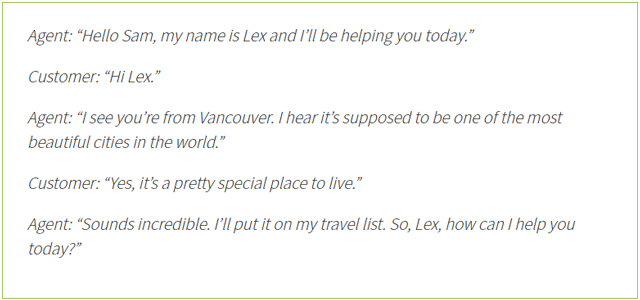
You see what we mean now?
Here’s what another expert, Leslie O’Flahavan, says about using your brand’s voice in her article 10 Writing Skills Agents Need to Chat with Customers…
When they chat, agents represent their company’s brand, so they should sound like the brand.
If, for example, you chat for a surf and skate clothing retailer, and your company’s marketing message is “We keep the world ripping and rocking,” you need to be able to use that brand voice in your chats.
It would be jarring to write, “It has been a pleasure assisting you in purchasing your shoes.” Better to write, “I know you’re going to like your dope kicks.”
Got the point now? Sure!
Also, pay special attention to what’s been said in Live Chat Best Practices by CustomerThink below.
It is common for live chat conversations to begin with scripted introductory phrases. Overuse of scripted phrases can set a negative tone and make the customer feel unimportant.
Taking the time to customize the introductory dialogue to complement page content, or at the very least overall website content, can go a long way to engaging a customer. Showing that you understand the customer’s needs and pain points is an ideal way to build rapport and increase brand loyalty.
Use personalized comments to set the customer at ease and to show a sincere desire to help.
But, the author warns you to be careful NOT to over-personalize it! Here’s the point…
There is a fine line between customizing a customer’s experience and going too far.
You may know that a customer has visited a particular product page ten times in the last 2 days – but it is not appropriate to share this data with the customer.
Divulging every little detail can make customers feel as if their privacy has been invaded, and may hinder the decision to purchase or continue with issue resolution. Use information gathered judiciously to add value to the conversation.
Here’s another important point when speaking about being professional, which is also listed among many others you should check out in the blog post 15 Live Chat Tips to Help You Chat Professionally with Customers.
Staying on topic while chatting with customers is important for several reasons. It avoids wasting precious time and leads to a prompter resolution.
Avoid sending your customers irrelevant information that might complicate an issue or hinder it from being solved. If a customer presents you with several topics that he or she needs help with, work to solve them one at a time.
Sometimes customers just enjoy having someone to talk to. If a customer gets off topic, be courteous, but try and discretely keep the conversation moving in the right direction, like in the following example:
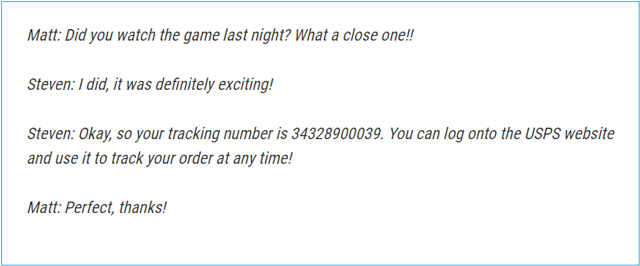
Here, you can see that Steven politely engaged in the topic that Matt presented, but professionally continued to move the chat towards its goal: resolution and customer satisfaction.
Here are a few more articles to help you figure out how personal it is (not) OK to get with your customers:
- The Fine Line Between Being Friendly and Being Their Friend
- Finding the Balance Between Connecting with Your Customers Personally and Professionally
- Getting Personal With Your Client
- Mixing Business and Personal: When Clients Get Too Close
Not all of them have to do specifically with live chat conversations, but they certainly offer helpful advice.
And last, but far from the least important piece of advice to remember – you speak on behalf of your employer, so act accordingly. Since this is also vital to understand, let’s just briefly talk about it.
Being Aware of Your Employer’s Preferences
When you’ve done everything we’ve discussed above, then it’s a matter of finding out from your employer if they have a preference.
When you figure that out, make sure you document their preference. Why would you bother to do so?
Here’s quite a good reason…
Imagine your employer tells you to send a particular response to every single customer who asks a certain question. Everything goes well until one customer doesn’t like your response and decides to make a fuss about it complaining to your employer or supervisor directly.
Your employer, then, criticizes the way you responded and communicated to that specific customer because they completely forgot it was their instruction given to you some time ago.
If you hadn’t documented the instructions your employer gave you, you could get into a trouble at that moment, right?
Luckily, you did it, so you can just remind your employer of your earlier mutual agreement:
I understand what seems to have caused the problem here and I’m really sorry, but you’ve told me to say this to all our customers asking that question. Here’s a reminder for you in case you’ve forgotten about it.” (Then, document your words showing the facts such as a screenshot of your employer’s message.)
NO way you can get into trouble when you’ve provided the proof of the EXACT words your employer used to instruct you on how to communicate with the customers in a particular situation.
In that case, they can only say something like this:
Gosh, I really said that but I completely forgot about it! Sorry, it’s obviously not your fault. I’ll sort it out”
Thus, remember – when you’re speaking on behalf of a business you need to be extra careful to remember and document what your employer told you because it saves confusion later.
Also, the approach of documenting everything will be super helpful when you start working in online stores and coming up against various new scenarios. There will always be new questions, new products or something new will constantly happen.
So, if you document the response that was correct in one situation, you can keep using it in every other similar or same situation that occurs in the future. In other words, you can start building a sort of a Knowledge Base, which will help you to remain consistent, professional, and save a lot of your time and energy.
Now, let’s briefly summarize what you’ve learnt about friendly greetings and chitchat so far, shall we?
In Summary
Although it may sound basic and obvious, not everyone understands the importance of a live chat greeting.
Greetings set the tone for the rest of the conversation and influence the future hopefully lasting relationship of the company with the customer.
They should be friendly and personalized, yet remain professional.
However, not every CSR gets at that intuitively. It requires some knowledge and practice to understand:
- How to overcome the fear of speaking to foreigners in a foreign language, which may be the underlying cause of some CSRs’ poor customer service
- How to get a live chat conversation started and keep the customers engaged in it
- When and how to draw the line so that you simultaneously remain friendly and professional
- You’re talking on behalf of your employer’s business and should always be aware of it
So, do the following quiz to show us whether you’ve grasped the main points of this topic. Looking forward to your high quiz scores!
Frequently Asked Questions
1. Is it advisable to say your name to the customer when providing live chat support?
a. Yes. As you would in an in-person conversation, greet your chat customers by name and share yours in return. The simple act of swapping names will remind your customer that they’re talking to a real human which can foster trust in your brand
b. No. They’re contacting the company so they do NOT need to know any individual CSR’s name
2. If your employer provided you with a good-quality script to use in live chat support, you should stick to it and NEVER choose your words on the fly.
a. True, because those high-quality scripts are specially designed to build your customers’ loyalty and satisfaction. So, you should always stick to them no matter what
b. False. Customers want genuine and personalized conversations with brands so it’s wise to go off the script in particular occasions. It’s always smart to match your customer’s tone when appropriate and keep the conversations light but to remain professional at the same time
3. “Hi ! Thanks for contacting . My name’s
a. Decent live chat greeting message template
b. Poor live chat greeting message template
4. “Hey there! Is there anything specific I can assist you with?” is a nice, friendly message to welcome a new website visitor via live chat and let them know you’re at their disposal if they need some help.
a. Yes. It can also be automated to save a CSR’s time
b. No
5. Which of the following is a BAD example of greeting a customer?
a. “Hi, we are pleased to hear from you. How are you doing?”
b. “Hello! My name’s. What can I do for you today?”
c. “Hi! What’s your problem?”
6. Which is the most appropriate way to proactively engage with your online store visitor browsing your pricing page and to offer your instant assistance?
a. “Hi! We are currently having special deals on. Interested?”
b. “Hi! Welcome to! How can I assist you?”
c. “Hi! Do you have any specific query regarding our pricing?”
7. “Welcome back. It’s good to see you again. How can I help you today?” is a perfectly tailored message to greet and initiate a conversation with:
a. A person visiting your online store for the first time
b. A customer who has just made a purchase from your online store
c. A visitor who’s currently browsing your store pricing page
d. A returning visitor to your online store
8. Chatting to the customer about your personal problems is a good way to show them you’re real and to connect with them better.
a. True. That will definitely make the customer trust you more.
b. False. You should be friendly and personalize the conversation but still keep it professional.
